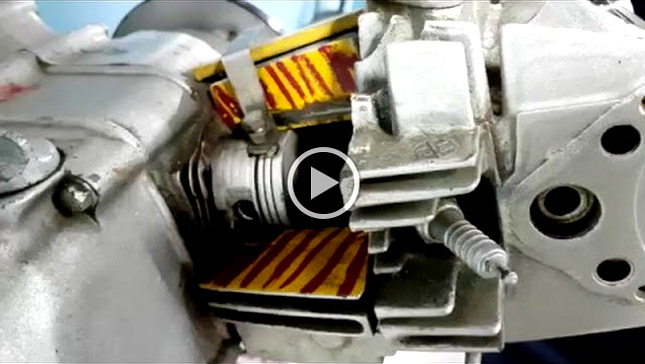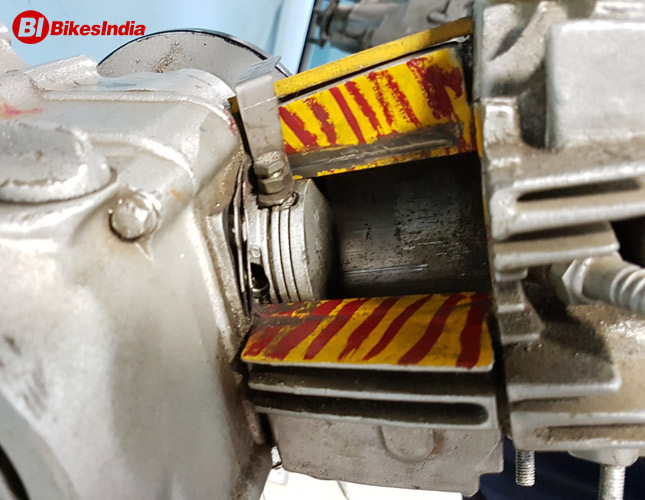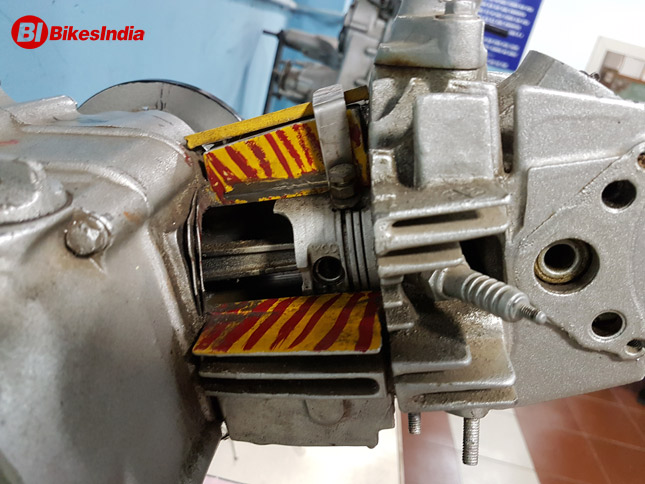We all love motorcycles, they are separated by brands, looks, the exhaust note and the way they handle. Each motorcycle is a sole beauty, built with its own significance. But every motorcycle is united by one thing, that is the functioning of the 4 stroke engine. Everyone can see how the motorcycle runs and sounds from the outside, but there is always this one question that arises in everyone's mind, how does it work inside? How does the Piston move? How does the Crankshaft work? When does the Sparkplug ignite? What is TDC? What is BDC? Thousands of questions like this arise in our minds.
 So we have a small solution for all the readers, we were lucky enough to find the cut section of a Hero Honda Splendor bike, which is a 4 stroke petrol engine. It is one of the most basic engines, that has ignited to the development of several other huge engines, here is how a 4 stroke petrol engine works.
So we have a small solution for all the readers, we were lucky enough to find the cut section of a Hero Honda Splendor bike, which is a 4 stroke petrol engine. It is one of the most basic engines, that has ignited to the development of several other huge engines, here is how a 4 stroke petrol engine works.
Four stroke spark ignition engine is also known as the petrol engine and is widely used in bikes and cars as the power unit. It converts the chemical energy of fuel into mechanical energy by the piston. In an engine, stroke is referred to the maximum distance traveled by the piston in a single direction. The piston is free to move only in upward and downward direction. In four stroke engine, the piston moves two times up and down and the crankshaft moves two complete revolutions to complete four piston strokes. The strokes are namely called Intake Stroke, Compression Stroke, Expansion Stroke and Exhaust Stroke.
Intake Stroke: During the Intake Stroke of spark ignition engine, the piston moves down from the Top end of the cylinder to the Bottom end of the cylinder and simultaneously Intake Valve opens. Due to the movement of Piston low pressure or vacuum is generated inside the Cylinder. Due to the vacuum, the Air-Fuel Mixture enters inside the engine. The intake valve remains open until the piston reaches the lower end of the cylinder. After which the intake valve closes and seals the cylinder preventing the excess fuel or air from entering inside.
During the Intake Stroke of spark ignition engine, the piston moves down from the Top end of the cylinder to the Bottom end of the cylinder and simultaneously Intake Valve opens. Due to the movement of Piston low pressure or vacuum is generated inside the Cylinder. Due to the vacuum, the Air-Fuel Mixture enters inside the engine. The intake valve remains open until the piston reaches the lower end of the cylinder. After which the intake valve closes and seals the cylinder preventing the excess fuel or air from entering inside.
RELATED ARTICLE: What Is Compression Ratio And How It Affects The Performance & Economy Of Your Motorcycle?
Compression Stroke:
After the piston reaches the bottom end of the cylinder, it starts moving up. Both valves are closed and the cylinder is sealed. The piston moves upward. This movement of piston compresses the air-fuel mixture into a small space between the top of the piston and cylinder head. At the end of compression stroke, the piston is at the top end of the cylinder.
Power Stroke: The Power Stroke is the major game changer amongst all the processes, in this stroke the maximum power is produced that keeps the engine running at the desired speed. At the end of the Compression Stroke, the piston is at the top end of the cylinder and an electric spark is generated by the Sparkplug that rapidly causes combustion thus burning the fuel inside the engine. The heat of the spark ignites the compressed air-fuel mixture. The air-fuel mixture then burns rapidly and produces high temperature up to 3300 Degree Centigrade. The high temperature causes very high pressure, which pushes down on the top of the piston. At the end of Power Stroke, the piston reaches the bottom end of the cylinder.
The Power Stroke is the major game changer amongst all the processes, in this stroke the maximum power is produced that keeps the engine running at the desired speed. At the end of the Compression Stroke, the piston is at the top end of the cylinder and an electric spark is generated by the Sparkplug that rapidly causes combustion thus burning the fuel inside the engine. The heat of the spark ignites the compressed air-fuel mixture. The air-fuel mixture then burns rapidly and produces high temperature up to 3300 Degree Centigrade. The high temperature causes very high pressure, which pushes down on the top of the piston. At the end of Power Stroke, the piston reaches the bottom end of the cylinder.
Exhaust Stroke:
When the piston reaches the bottom end of the cylinder after the Power Stroke, the Exhaust Valve opens. At this time due to the burnt gasses inside the cylinder, the pressure inside the cylinder is slightly higher from atmospheric pressure. This pressure difference allows burnt gasses to escape through the exhaust valve and the pistons move through the top end of the cylinder. At the end of the exhaust, all burnt gasses are sent out. Now again intake valve opens and this process continues until the vehicle is turned off.
We hope this information was useful for every reader, stay tuned for the working of the 2-Stroke Petrol Engine. Ride safe! Ride hard!
By: Rishath Suresh
 So we have a small solution for all the readers, we were lucky enough to find the cut section of a Hero Honda Splendor bike, which is a 4 stroke petrol engine. It is one of the most basic engines, that has ignited to the development of several other huge engines, here is how a 4 stroke petrol engine works.
So we have a small solution for all the readers, we were lucky enough to find the cut section of a Hero Honda Splendor bike, which is a 4 stroke petrol engine. It is one of the most basic engines, that has ignited to the development of several other huge engines, here is how a 4 stroke petrol engine works. Four stroke spark ignition engine is also known as the petrol engine and is widely used in bikes and cars as the power unit. It converts the chemical energy of fuel into mechanical energy by the piston. In an engine, stroke is referred to the maximum distance traveled by the piston in a single direction. The piston is free to move only in upward and downward direction. In four stroke engine, the piston moves two times up and down and the crankshaft moves two complete revolutions to complete four piston strokes. The strokes are namely called Intake Stroke, Compression Stroke, Expansion Stroke and Exhaust Stroke.
Intake Stroke:
 During the Intake Stroke of spark ignition engine, the piston moves down from the Top end of the cylinder to the Bottom end of the cylinder and simultaneously Intake Valve opens. Due to the movement of Piston low pressure or vacuum is generated inside the Cylinder. Due to the vacuum, the Air-Fuel Mixture enters inside the engine. The intake valve remains open until the piston reaches the lower end of the cylinder. After which the intake valve closes and seals the cylinder preventing the excess fuel or air from entering inside.
During the Intake Stroke of spark ignition engine, the piston moves down from the Top end of the cylinder to the Bottom end of the cylinder and simultaneously Intake Valve opens. Due to the movement of Piston low pressure or vacuum is generated inside the Cylinder. Due to the vacuum, the Air-Fuel Mixture enters inside the engine. The intake valve remains open until the piston reaches the lower end of the cylinder. After which the intake valve closes and seals the cylinder preventing the excess fuel or air from entering inside.RELATED ARTICLE: What Is Compression Ratio And How It Affects The Performance & Economy Of Your Motorcycle?
Compression Stroke:
After the piston reaches the bottom end of the cylinder, it starts moving up. Both valves are closed and the cylinder is sealed. The piston moves upward. This movement of piston compresses the air-fuel mixture into a small space between the top of the piston and cylinder head. At the end of compression stroke, the piston is at the top end of the cylinder.
Power Stroke:
 The Power Stroke is the major game changer amongst all the processes, in this stroke the maximum power is produced that keeps the engine running at the desired speed. At the end of the Compression Stroke, the piston is at the top end of the cylinder and an electric spark is generated by the Sparkplug that rapidly causes combustion thus burning the fuel inside the engine. The heat of the spark ignites the compressed air-fuel mixture. The air-fuel mixture then burns rapidly and produces high temperature up to 3300 Degree Centigrade. The high temperature causes very high pressure, which pushes down on the top of the piston. At the end of Power Stroke, the piston reaches the bottom end of the cylinder.
The Power Stroke is the major game changer amongst all the processes, in this stroke the maximum power is produced that keeps the engine running at the desired speed. At the end of the Compression Stroke, the piston is at the top end of the cylinder and an electric spark is generated by the Sparkplug that rapidly causes combustion thus burning the fuel inside the engine. The heat of the spark ignites the compressed air-fuel mixture. The air-fuel mixture then burns rapidly and produces high temperature up to 3300 Degree Centigrade. The high temperature causes very high pressure, which pushes down on the top of the piston. At the end of Power Stroke, the piston reaches the bottom end of the cylinder.Exhaust Stroke:
When the piston reaches the bottom end of the cylinder after the Power Stroke, the Exhaust Valve opens. At this time due to the burnt gasses inside the cylinder, the pressure inside the cylinder is slightly higher from atmospheric pressure. This pressure difference allows burnt gasses to escape through the exhaust valve and the pistons move through the top end of the cylinder. At the end of the exhaust, all burnt gasses are sent out. Now again intake valve opens and this process continues until the vehicle is turned off.
We hope this information was useful for every reader, stay tuned for the working of the 2-Stroke Petrol Engine. Ride safe! Ride hard!
By: Rishath Suresh











